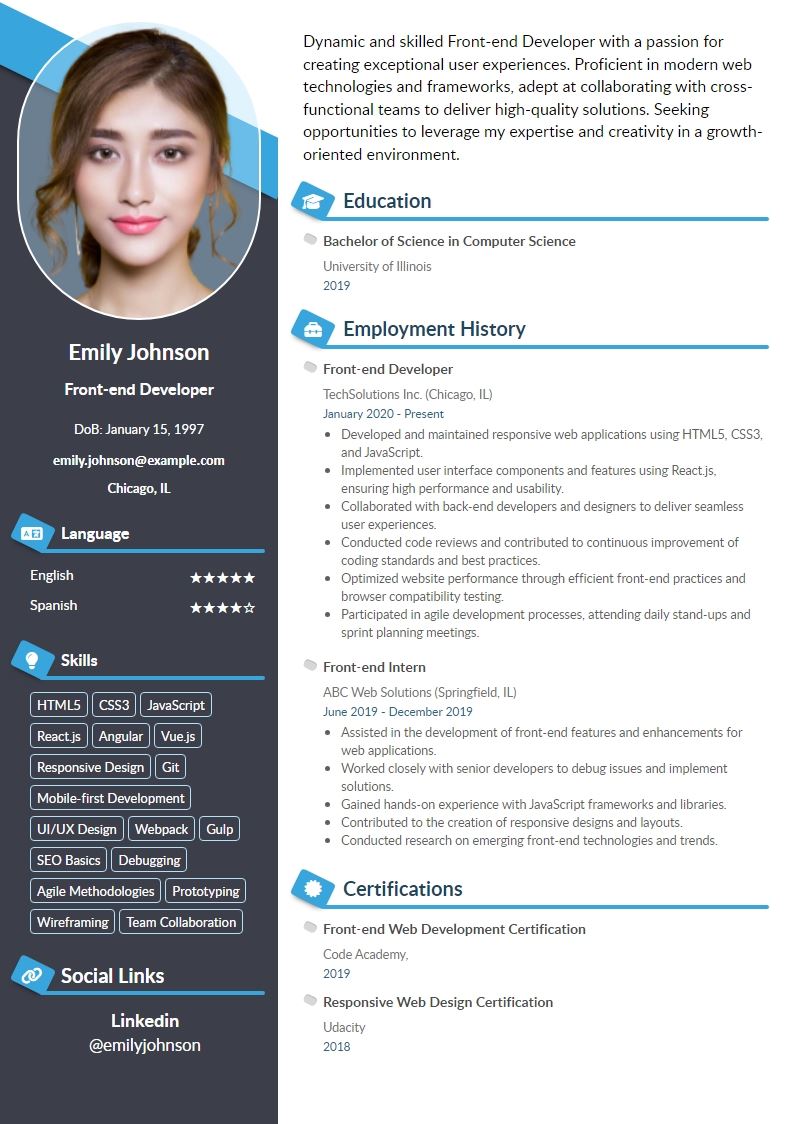Front-end Developer Resume Example
How to Write a Front-end Developer Resume
In the fast-paced world of technology, standing out as a Front-end Developer requires more than just technical prowess; it demands a well-crafted resume that effectively communicates your skills, experiences, and potential contributions to prospective employers. Whether you're an aspiring developer or a seasoned professional looking to advance your career, here are essential tips and guidelines to create a compelling Front-end Developer resume.
1. Begin with a Clear Objective:
Start your resume with a concise objective statement that highlights your career goals and what you bring to the table. Tailor it to the specific job you're applying for, showcasing your enthusiasm and expertise in front-end development.
2. Highlight Relevant Skills:
List your technical skills prominently, focusing on front-end technologies such as HTML5, CSS3, JavaScript, and popular frameworks like React.js, Angular, or Vue.js. Include any additional tools, libraries, or methodologies you're proficient in, such as Git, Webpack, or Agile development.
3. Showcase Your Experience:
Detail your professional experience, emphasizing your contributions to front-end projects. Highlight specific achievements, such as developing responsive web applications, optimizing website performance, or collaborating with cross-functional teams to deliver user-centric solutions.
4. Feature Impactful Projects:
Include a section showcasing notable projects you've worked on. Describe each project briefly, outlining your role, the technologies used, and any challenges overcome. Demonstrate your ability to translate design concepts into functional and visually appealing interfaces.
5. Provide Education and Certifications:
List your educational background, focusing on relevant degrees, coursework, or certifications in computer science, web development, or related fields. Highlight any additional certifications or training programs that demonstrate your commitment to continuous learning and professional development.
6. Optimize for ATS:
Many employers use Applicant Tracking Systems (ATS) to screen resumes. Ensure your resume is ATS-friendly by using relevant keywords, formatting it cleanly, and avoiding graphics or unusual fonts that may hinder parsing.
7. Keep it Concise and Readable:
Limit your resume to one or two pages, focusing on essential information and avoiding unnecessary details. Use clear headings, bullet points, and concise language to make it easy for recruiters to skim through and find relevant information quickly.
8. Customize for Each Application:
Tailor your resume for each job application, aligning your skills and experiences with the specific requirements of the role. Research the company and job description to understand their needs and emphasize how you can contribute effectively.
9. Proofread and Edit:
Before submitting your resume, proofread it thoroughly to ensure it's free from grammatical errors, typos, or formatting issues. Consider asking a friend or colleague to review it as well, gaining fresh perspectives and valuable feedback.
10. Include Contact Information:
Provide your contact information prominently at the top of your resume, including your full name, phone number, email address, and LinkedIn profile. Make it easy for recruiters to reach out to you for further discussions or interviews.
In conclusion, crafting an effective Front-end Developer resume requires a combination of technical expertise, clear communication, and strategic presentation. By following these tips and guidelines, you can create a compelling resume that highlights your skills, experiences, and potential contributions, setting yourself apart in the competitive job market. Remember to continuously update and refine your resume as you gain new experiences and skills, ensuring it remains a powerful tool in your career advancement journey.
